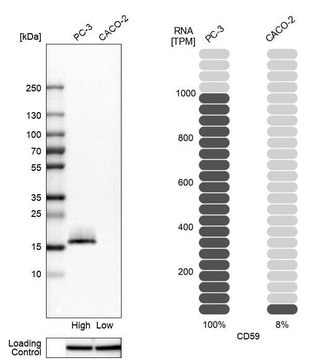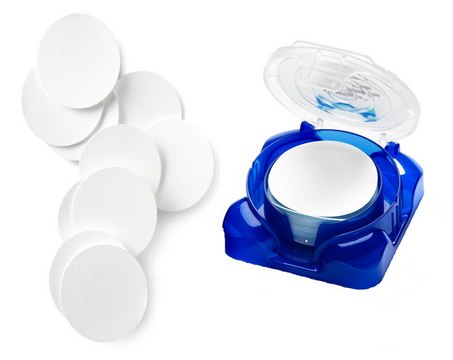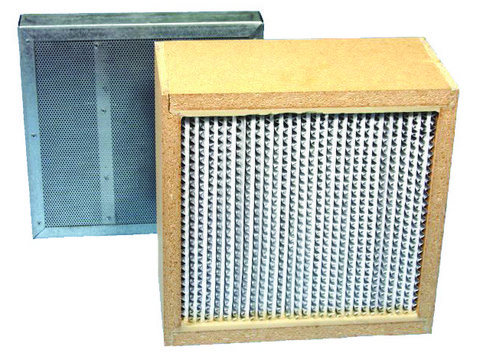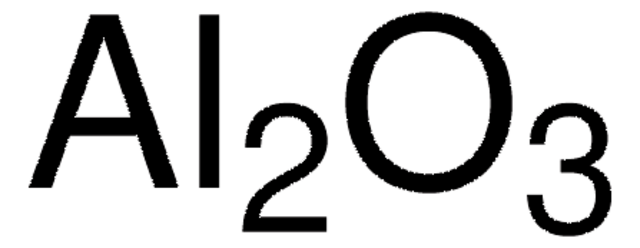MAB1759
Anti-CD59 Antibody, clone 2/24
clone 2/24, Chemicon®, from mouse
Synonym(s):
Protectin
Sign Into View Organizational & Contract Pricing
Select a Size
All Photos(1)
Select a Size
Change View
About This Item
UNSPSC Code:
12352203
eCl@ss:
32160702
NACRES:
NA.43
Recommended Products
biological source
mouse
Quality Level
antibody form
purified immunoglobulin
antibody product type
primary antibodies
clone
2/24, monoclonal
species reactivity
human
manufacturer/tradename
Chemicon®
technique(s)
flow cytometry: suitable
immunofluorescence: suitable
isotype
IgG1
NCBI accession no.
General description
BIOCHEMISTRY:
p I = 6.1
p I = 6.1
Specificity
This antibody binds to a 17-25kD glycoprotein (Fletcher et al., 1990a,b) which is distributed on human cells and has a glycosyl-phosphatidylinositol (GPI) linkage to the plasma membrane(Hadam, 1989). It is identical to other CD59 monoclonals, MEM-43 and YTH 53.1, defined at the 4th International Conference on Human Leucocyte Differentiation Antigens(Davies et al., 1989; Stefanova et al., 1989). CD59 is an inhibitor of attack by autologous complement(Ojcius et al., 1990) possibly by limiting incorporation of C9 into the membrane complex(Rollins & Sims, 1990; Meri et al., 1990). GPI linked proteins such as CD59 are deficient on cells from patients with the acquired clonal disorder paroxysmal nocturnal haemoglobulinuria (PNH) in which the erythrocytes are susceptible to lysis by complement and leading to anemia(Rosse, 1990). Evidence suggests that CD59 may be the most important complement regulatory protein missing in PNH(Fletcher et al., 1990; Yamashina et al., 1990).
Cell reactivity (Fletcher et al., 1990a,b; Hadam, 1989):
The antibody reacts with all leucocytes, platelets, fibroblasts, erythrocytes and most cell lines. It is negative on U937 and Daudi cell lines. It is reduced on affected cells from patients with PNH with a distribution reflecting the clonal nature of the disease.
Cell reactivity (Fletcher et al., 1990a,b; Hadam, 1989):
The antibody reacts with all leucocytes, platelets, fibroblasts, erythrocytes and most cell lines. It is negative on U937 and Daudi cell lines. It is reduced on affected cells from patients with PNH with a distribution reflecting the clonal nature of the disease.
Immunogen
Human erythrocytes
Application
Detect CD59 using this Anti-CD59 Antibody, clone 2/24 validated for use in FC & IF.
Research Category
Inflammation & Immunology
Inflammation & Immunology
Research Sub Category
Immunoglobulins & Immunology
Immunoglobulins & Immunology
This monoclonal is useful in studies of complement and homologous restriction of complement action of the properties of GPI linked proteins and in the characterisation of cells from patients with PNH.
SUGGESTED USAGE DILUTION
1. Flow cytometry and indirect immunofluorescence 1:25
Dilute with isotonic buffer. Use 50 μl of the appropriate dilution per 1x10E6 cells in 100 μl buffer.
SUGGESTED USAGE DILUTION
1. Flow cytometry and indirect immunofluorescence 1:25
Dilute with isotonic buffer. Use 50 μl of the appropriate dilution per 1x10E6 cells in 100 μl buffer.
Physical form
Format: Purified
Purified immunoglobulin. The antibody is supplied in phosphate buffered saline, pH 7.4, containing 0.2% bovine serum albumin and 0.1% sodium azide. The characteristics of each lot are tested by electrophoresis and flow cytometry.
Storage and Stability
Store at 2 to 8°C, for up to 6 months. For prolonged periods, store below -20°C in undiluted aliquots. AVOID REPEATED FREEZE/THAW CYCLES.
WARNING: The monoclonal reagent solution contains 0.1% sodium azide as a preservative. Due to potential hazards arising from the build up of this material in pipes, spent reagent should be disposed of with liberal volumes of water.
WARNING: The monoclonal reagent solution contains 0.1% sodium azide as a preservative. Due to potential hazards arising from the build up of this material in pipes, spent reagent should be disposed of with liberal volumes of water.
Other Notes
Concentration: Please refer to the Certificate of Analysis for the lot-specific concentration.
Legal Information
CHEMICON is a registered trademark of Merck KGaA, Darmstadt, Germany
Disclaimer
Unless otherwise stated in our catalog or other company documentation accompanying the product(s), our products are intended for research use only and are not to be used for any other purpose, which includes but is not limited to, unauthorized commercial uses, in vitro diagnostic uses, ex vivo or in vivo therapeutic uses or any type of consumption or application to humans or animals.
Not finding the right product?
Try our Product Selector Tool.
Storage Class
12 - Non Combustible Liquids
wgk_germany
WGK 2
flash_point_f
Not applicable
flash_point_c
Not applicable
Certificates of Analysis (COA)
Search for Certificates of Analysis (COA) by entering the products Lot/Batch Number. Lot and Batch Numbers can be found on a product’s label following the words ‘Lot’ or ‘Batch’.
Already Own This Product?
Find documentation for the products that you have recently purchased in the Document Library.
Our team of scientists has experience in all areas of research including Life Science, Material Science, Chemical Synthesis, Chromatography, Analytical and many others.
Contact Technical Service





